Page 463 - EL Grade 5 Teacher Guide
P. 463
Grade 5: Module 1: Unit 3: Lesson 1
■ Direct students’ attention to the rst paragraph of the monologue. Invite students to follow along, reading silently in their heads as you read the rst paragraph aloud.
■ Using a total participation technique, invite responses from the group:
“What is the gist of this part of the text? What is it mostly about?” (Miguel’s father woke
him up in the middle of the night because Esperanza’s house was on re.)
“Are there any words you are not sure of the meaning? What are they?” (Responses will vary.)
■ Model identifying unfamiliar words as necessary, reminding students that for the rst read it is okay to not understand every unfamiliar word.
■ Build on the gist statements students o ered, elaborating as necessary and modeling record- ing the statement in the margin of the monologue. Remind students that they can draw or write their gist statements, and that they are just notes to help them remember what that part of the monologue is mostly about.
■ Invite students to work with their groups to reread the remainder of the monologue and to discuss the gist of each paragraph. Remind students that the gist doesn’t have to be written in full sentences. It can be just a few words to explain what the text is mostly about or sketches with labels, as long as they can read and understand what they have recorded.
■ Circulate to support students in rereading and nding the gist.
■ After 5 minutes refocus the whole group and use a total participation technique to select
students to share the gist of each paragraph. Listen for:
— Paragraph 2: Miguel’s father went inside Esperanza’s house and told Miguel to wait outside.
— Paragraph 3: Miguel saw Esperanza and her mother safely leave their house, but realized that Abuelita was still inside.
— Paragraph 4: Miguel ran into the burning house to look for Abuelita. He found her and carried her outside.
— Paragraph 5: Miguel’s father knocked him to the ground and rolled him over and over because his shirt was on re.
— Paragraph 6: Miguel was not badly burned, and was thankful to have helped save Esperanza and her family.
Meeting Students’ Needs
■
■
For ELLs and udents who may need additional support with comprehension: Prepare icky notes with pre-written words or drawings based on the gi of dif- ferent paragraphs of the monologue. As udents read the monologue with their group, they can match the gi represented on the icky notes with each section of the text. (MMAE)
For ELLs and udents who may need additional support with reading: During the reading for gi , encourage udents to gure out the meaning of key unfamiliar words in context or use a translation dictionary to under and unfamiliar words. You may want to po an anchor chart that includes rategies for guring out unfamiliar words and direct udents’ attention to it. For more intensive support, provide individual checkli s for udents with their preferred rategies. (MMR)
EL Education Curriculum 439
_ELED.TG.05.01.indb 439
12/4/18 11:49 PM


